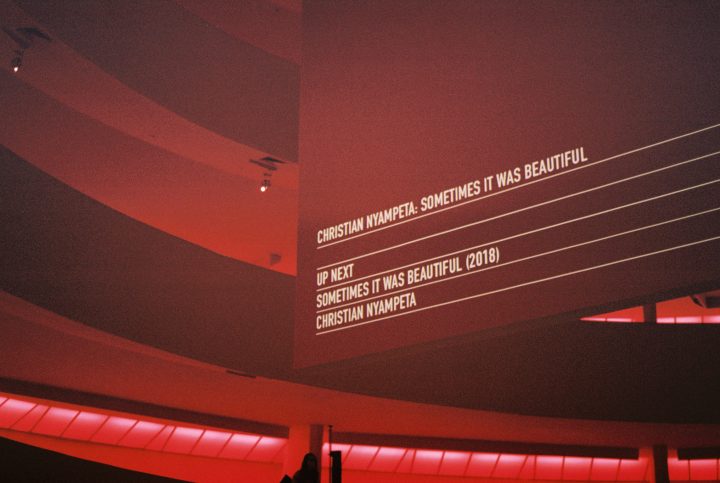
Ousmane Sembène, the august “father of African cinema” would often refer to films as cours du soir, or night school. His belief in cinema as an accessible form of public education is one shared by the artist Christian Nyampeta, who has transformed the Guggenheim into a space for collective study, displaying works of his own alongside others that examine Pan-African colonial histories with textbook-like reserve.
Because the exhibition’s anti-colonialist missives are exceptionally restrained rather than displaying outright rebellion, Nyampeta’s night school feels open to all. On one hand, this accessibility invites viewers who might want to learn about these histories without having to endure the traumatizing imagery that often clings to colonial depictions. On the other hand, the restraint makes the exhibition feel too safe at times, particularly inside an institution facing recent allegations of systemic racism.

In the first level gallery, minimalistic black and white scroll drawings stretch across the floor and ceiling, each inspired by pages from his grade school textbooks. Nyampeta also places a chalkboard and a round purple table with a couple of microphones and keyboards in the room to evoke the Transcription Centre, a London recording studio that, in the 60s, became an archive for taped interviews with African writers. Viewers can sit at the table, but, perhaps due to COVID restrictions, cannot interact with the audio equipment, which is unusually sparse and haphazardly placed. While the scrolls and furniture — also designed by the artist, to recall the original Centre — both evoke nostalgia, little else binds them, and the gallery feels like a missed opportunity to encourage a collective or interactive experience.
Nearby, scattered along the walls of the rotunda, Nyampeta has drawn murals of various animals and vistas and positioned his three act radio play, The Africans, about a fictional Nigerian poet and activist, to play from a speaker at the top of the ramp.
On a screen at the center of the darkened rotunda, Nyampeta has programmed a series of moving image works that include his 2018 film, Sometimes it was Beautiful, shorts from the Boda Boda Lounge Video Art festival, and miscellaneous talks and activities with local collaborators. In Sometimes it was Beautiful, the artist arranges a fantasy cast of historical figures. They’ve gathered to screen Sven Nykvist’s (Ingmar Bergman’s renowned cinematographer) documentary In the Footsteps of the Witch Doctor, a “documentary” about Swedish missionaries in Congo with staged elements a la Nanook of the North. In attendance are Winnie Mandela, Andrei Tarkovsky, Rioberta Menchu, Wole Soyinka (played by Makda Embaie, Dale Harding, Ashraf Marefi, and Samuel Girma, respectively) and Sven Nykvist himself. It is mentioned that Yasser Arrafat and Leena Gandhi left midway through the screening, disturbed. Nyampeta doesn’t show much from Nykvist’s film but he does include the reactions to it — how unsettled the film’s lies and misrepresentations have made attendants. Nykvist himself concedes that the film is problematic and that he staged scenes to make them more aesthetically sound. Still, even after listening to the audience, Nykvist counters, “If my films are indeed traces of crimes, wouldn’t erasing [evidence of his misdeeds] amount to another crime?” Nyampeta attempts to reverse Nykvist’s white gaze by framing him from a distance and looking down at him from above, placing him under a scrutinizing lens. But what do we learn about Nykvist that we don’t already know? That the audience in Sometimes it was Beautiful doesn’t already know?

As a whole, while Nyampeta manages to evince a vague sense of artist takeover, the installation feels scant. I wished for more drawings in the rotunda, that his gallery of scrolls had been more plentiful, and that the precious architecture of the Guggenheim felt more desecrated. As it stands, the scale of Frank Lloyd Wright’s architecture swallows up Nyampeta’s sparse exhibition. But within this school for all, it remains curious that only Nykvist, the perpetrator of a cultural distortion that harms everyone in Nyampeta’s fantasy audience, comes away unharmed, stimulated with questions and newfound knowledge.
Christian Nyampeta: Sometimes It Was Beautiful continues through June 21 at the Guggenheim Museum (1071 Fifth Avenue, Upper East Side, Manhattan). The exhibition was curated by Xiaoyu Weng.
0 Commentaires